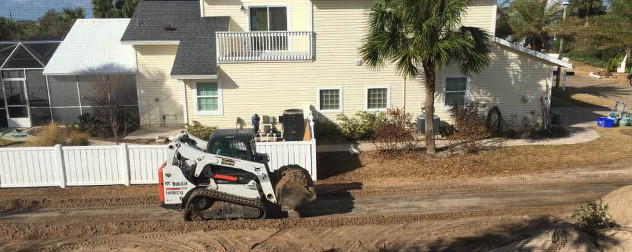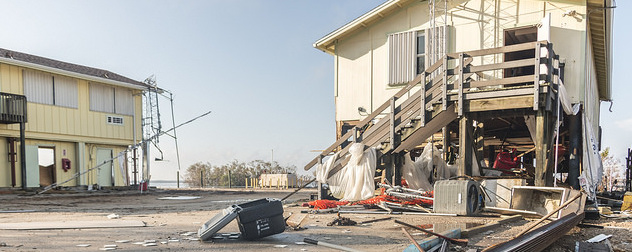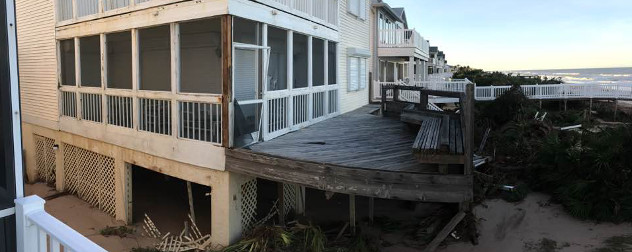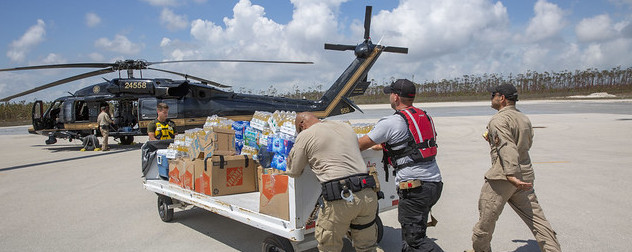
The homeowners association in the author's community plowing the street on Oct. 16.
Photo by Larry Elkin.
When Hurricane Matthew pulled away from the northern Florida beach where my wife and I have a home, I returned to find about three feet of sand surrounding the house, along with palmetto trees, dock pilings and a displaced gate from Marineland, which is several miles away.
I immediately wrote off the two outdoor heat pumps that had been doused in salt water from the storm surge and then half-buried in the sand. Apart from the heat pumps and a single dislocated support post for the backyard deck, damage to the house itself was minimal. And thanks to excellent luck and some foresighted architecture, the water only entered our garage to a depth of about 18 inches; all of the living space, which is elevated above the garage, stayed dry.
We were very fortunate, and I knew it. So did the crabs who were scampering around the sand in our driveway.
Most of the neighbors on our side of the beachfront street fared similarly. Some lost their decks (ours, recently rebuilt, was newer and stronger) or dune walkovers; only the few who had created living space on the ground level lost any furniture or carpeting. But we all had sand, tons and tons of it. And that sand has got to go.
That process has already begun. Over the weekend, our homeowners association brought in a team to plow the sand and muck from the association-owned street. The sand on our lots is each homeowner’s responsibility, however. My first step was to hire my very reliable landscaper, who has his own Bobcat front-end loader, to clear out the driveway and dig out the old heat pumps so they can be replaced.
Regular homeowners’ insurance generally excludes all flood losses, although policy riders vary and some of my neighbors’ costs, such as for loss of use of the home, might conceivably be covered. In my case, I assumed flood insurance would handle cleanup and repairs, apart from the large deductible that applies to hurricane-induced losses. It was abundantly clear that all the sand, as well as the debris, was carried by the waves that washed over the dunes behind our homes. If there was any doubt, the dozens of dead palmettos that formerly anchored the dune and now littered our lots was enough to dispel it.
But I was naive, as Michael and Geraldine Torre could have told me.
The Torres live in New York but owned beachfront property in the New Jersey shore community of Mantoloking when Sandy came ashore in 2012. Just like me, the Torres returned to find their property covered in sand and debris and, like me, they expected their flood insurance to pay for its removal.
But it didn’t for them, and it won’t for me.
Virtually all basic residential flood insurance in this country is issued under the National Flood Insurance Program, and it all carries the same form – the Standard Flood Insurance Policy. Different companies may issue policies, but they merely collect the premiums and administer claims on behalf of the federal government, which underwrites the insurance. The Federal Emergency Management Agency trains claims adjusters on how to determine which losses are covered and which are not.
The standard policy covers buildings and, if the homeowner elects, can also cover personal property contained in the residence or certain outbuildings. There are significant limitations, such as what can be covered in parts of the building that are below the living spaces, like my garage. Flood insurance will handle some other costs such as cleanup and restoration, but only for insured property. And that is where the Torres and I ran into a problem.
Liberty Mutual, which issued the Torres’ policy, paid for the losses incurred inside their beach house, and it paid to remove sand from the house. But it denied coverage for about $15,000 that the Torres spent to remove the sand and debris deposited on their property outside the home. That sand was not inside the building, and it was not their personal property (at least not before Sandy gave them possession of it), so the insurer determined it was not covered.
The Torres sued but lost in federal district court. They appealed but lost again in the Third U.S. Circuit Court of Appeals in Philadelphia. A three-judge panel unanimously held that the standard flood insurance policy is unambiguous about what it covers and what it does not – land and landscaping, for example, are specifically excluded. So the removal of sand from the Torres’ land was not reimbursable under the federal flood insurance program.
I am surprised, and I think the Third Circuit judges were too, that this is the first time this issue has been litigated to that level. A North Dakota district judge did find in favor of a homeowner who sought debris removal after river flooding in 2011, but that decision was reversed on other grounds, and the Philadelphia appellate court did not find the North Dakota district judge’s decision persuasive.
I could take my chances and sue my own insurer when, as I expect, it declines to allow payment for my sand removal. But I won’t. For one thing, I doubt the amount of money involved in my case would make it worth the effort. More significantly, I doubt I would have much chance of winning. Although there are some in the legal and insurance fields who disagree, it strikes me that the Third Circuit has logic and contract language on its side. If Congress wanted to write a law that would cover land cleanup costs under federal flood insurance, it knew how to do so.
Cases like that of the Torres might generate some legislative action, but I doubt it. If anything, the political winds are blowing hard against beachfront development, including homes like mine, which was built in the 1980s before hurricane losses and potential sea level rises were such a hot political issue. I don’t see much chance that lawmakers will want to further subsidize the costs of living in places dangerously close to the waves. I don’t have a problem with that.
People who buy homes near beaches generally don’t mind dealing with sand. The Torres had theirs; I now have mine. It looks like it remains our problem to handle on our own.














October 18, 2016 - 10:24 am
I volunteered after Sandy at a homeless shelter and bumped into a family that, like you, HAD flood insurance. When I asked why they were in a homeless shelter, they frustratingly told me that the policy doesn;t cover loss of use as a traditional homeowners policy would. Worse for all homeowners, is that you can’t buy loss of use coverage for flood even if you want it.
The NFIP policy is not even insurance. It is like buying an Aflac policy to cover major medical. It just isn;t going to do the job.
October 21, 2016 - 3:19 pm
Many consumers even with great coverage will have questions very similar to Mr. Elkin’s. Until a storm hits, even the best-informed consumer might not be aware of the specific language and limits of their policies, so we want to help. We offer a dedicated Hurricane Matthew website at http://www.myfloridacfo.com/Division/Consumers/hurricanematthew.htm and the “Homeowners Claims Bill of Rights,” which is an excellent resource when it comes to what the insurance companies’ responsibility is in terms of timeliness and response during the claims process. Aside from the online resources, our Consumer Services Insurance Helpline is staffed with experts Monday– Friday 8:00 am – 5:00 pm EST to help consumers with any questions at 1-877-693-5236.